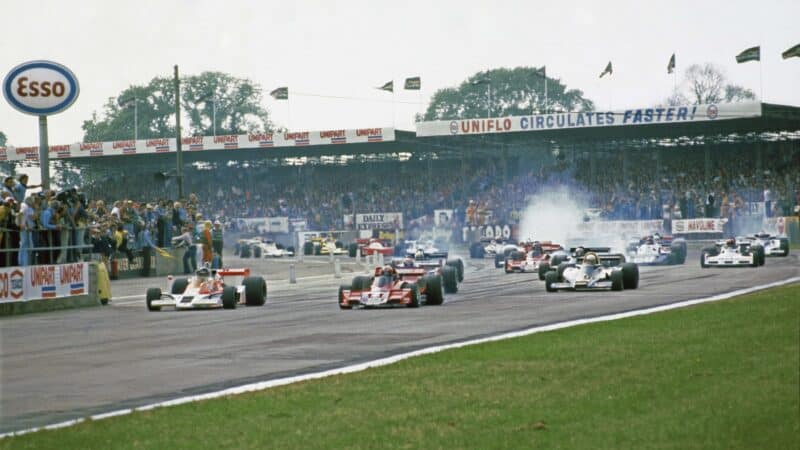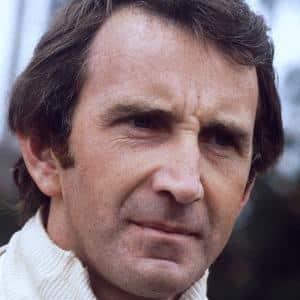A flare of colour — John Watson on the exuberance of 1970s racing
John Watson recalls how Formula 1 provided a dazzling escape from the gloom of 1970s Britain – a decade full of enormous personalities, tech gambles... and James Hunt

Getty Images
Thruxton, March 30, 1970, European Formula 2. My second race on the British mainland. I turned up with a private Brabham BT30 with a couple of ex-Roy Winkelmann engines, completed qualifying on the Goodyear tyres that were supplied, and ended up on the front row of the grid for one of the heats alongside the so-called king of F2 Jochen Rindt and Jacky Ickx. A surreal experience.

That weekend in the first months of a new decade, my car had a tube frame, treaded tyres and fairly rudimentary aerodynamics. It was not a lot different to what my forebears had been driving 10 years earlier. Look at that period and slick tyres were the first ‘big thing’ when F1 adopted them for 1971. Aerodynamics didn’t change things dramatically in the first half of the decade, but the second half was a different story as Colin Chapman’s Team Lotus harnessed underfloor ground effects.
I was working with Gordon Murray as a Brabham driver by then. Gordon had devised the Brabham BT46 with surface-cooling radiators in his signature triangulated monocoque. The panels were set in at a 45-degree angle with the idea of being a far more aerodynamically efficient form of cooling. It turned out to be a total disaster, it just didn’t work – after a lap the car was boiling like a kettle. But the fact there was no drag from a conventional radiator gave it the equivalent of 100bhp more, an unbelievable difference. We did a back-to-back test with a jury-rigged conventional car and it was like putting the handbrake on. Gordon was the ultimate lateral thinker of that era.
He continued on that theme with the BT46B fan car, a response to Chapman’s Lotus 79 which he couldn’t replicate with our Alfa Romeo flat-12 motor. He looked back and saw what Jim Hall had done in Can-Am with Chaparral, drove the fan via the gearbox and in its initial form, even at Sweden 1978 where my team-mate Niki Lauda won easily on its debut, BT46B was basic but very effective.
“The idea of kerbs back then was to stop you abusing track limits”
The concern F1 faced was if Brabham was allowed to run it for the rest of the year it would probably drive other teams to make an appropriate fan for a Cosworth-engined car. Chapman was off-the-radar apoplectic because he saw what Gordon had done had such an advantage over a ground-effect car. Because the fan was driven by the gearbox its operation was engine-speed related. If you were doing 10,000rpm in first gear the car was sucking down as hard as it would at 10,000rpm in sixth gear. That was a massive advantage in low- and medium-speed corners, whereas the power of conventional aerodynamics and ground effect was dependent on road speed. The square of the speed increases the downforce, so ground-effect cars were most effective in high-speed corners. At slower circuits the Brabham would clearly have had an advantage, as it did that day at twisty Anderstorp. Chapman nearly went nuts and got his partner in crime Mario Andretti to stir up the other drivers and teams to say under no circumstance was this a safe concept. So our boss Bernie Ecclestone withdrew it.
But what a time. The second half of the 1970s was a very exciting era. I don’t think there has been such an era before or since: six-wheeled F1 cars, Renault’s turbo engine, a wide variety of racing shapes and colours. Today, engineering is relatively off the shelf. There is little lateral thinking and individuality because the regulations mean all F1 cars look ostensibly the same. Everything is regulated. It’s all much of a muchness.

Jackie Stewart, François Cevert and Emerson Fittipaldi, 1973 Argentine GP
Getty Images
At the same time, in the real world we should never forget how difficult the 1970s were. It’s a two-sided story. We had strikes, power cuts, three-day weeks – society was in a bad place. We were being browbeaten through the papers and the BBC, and everything was doom and gloom. I’d come over from Northern Ireland and in that era the country I grew up in was effectively in a state of civil war. Appalling atrocities were taking place. Once I left in 1970 effectively I was living in England, as I still do. But the shadow of the state of things in my homeland was always there, always disturbing because my family lived there, and you never knew whether they might become caught up in something not of their making.
Consider the contrast of the world I now found myself living in. In May 1973 I went to the Monaco GP for the first time. I drove from Nice airport, along the coast, and arrived in Monte Carlo, down from the train station to the harbour. Oh my God. I couldn’t believe it. In the UK at that time, anything to do with wealth, or the perception of wealth, was almost considered criminal. Yet here we were, the sun was out, the sea was blue, there was a harbour full of incredible boats, incredible cars and incredible-looking people. This was sexy European wealth, which we didn’t have. The effect it had on me was hard to explain because I realised we were being told a pack of lies. Wealth is not a bad thing, wealth is a good thing. It’s the distribution of wealth that is the issue. It was the first time I’d ever experienced seeing first-hand the level of money there is in the world.
The first time I went to North America was also in 1973, when I was driving for the Gulf Wyer sports car team. We did the Daytona 24 Hours, flew into Miami and again it was a different world, based on an open and free society. I’d never been to a shopping mall or a fast-food restaurant. It was such a contrast to what we had in Europe.

James Hunt and Watson lead at the 1977 British GP
Grand Prix Photo
I witnessed the acceleration of money coming into the sport, with smart young people who weren’t hung up by what we used to do. The Ferrari thinking of F1 being all about the engine was of the past. Clever people at Cosworth and Hewland made very good engines and gearboxes that enabled anybody who could raise enough money to get a couple of cars together. I reflect back and I know some contemporaries don’t agree: what I liked about the 1970s was any man and every man could go out, buy a motor and gearbox, get someone to design a chassis and go F1 racing. Look at Silverstone in 1977: there were 40 cars entered with a pre-qualifying session to get it down to 30, and out of that 30, 26 made it through to the grand prix. Today we’ve got F1 arguing about an 11th team. I think that sucks.
But on safety… I look at some of the chassis from that era now and think, “There by the grace of God go I.” Likewise, circuits hadn’t moved far from the 1960s. Largely because of the efforts made by Jackie Stewart and a few others a slow change came on, but it took time, well into the 1980s for it to feed through.
What I love about race circuits back then, when you look at old footage, is what I call aggressive kerbs. The idea of kerbs back then was to stop you abusing track limits. I really wish we could have track demarcation at the level we had back in the 1970s. I don’t know the degree of pride a driver has today driving a grand prix track. Watching at somewhere like Bahrain, there’s barely a corner of the circuit where they aren’t running out wide, and not just on the exit but on the entry too. Where is the pride in being a skilful racing driver when there is nothing there to stop you doing it? I’d like to see drivers getting close to that kerb, but not going over it, driving with skill and precision like we had to. We don’t have that today.
